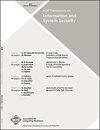对抗性文体学:规避作者身份识别以保护隐私和匿名性
Q Engineering
ACM Transactions on Information and System Security
Pub Date : 2012-11-01
DOI:10.1145/2382448.2382450
引用次数: 199
摘要
文体学的使用,通过纯粹的语言手段来识别作者,为文学、历史和刑事调查的突破做出了贡献。现有的文体学研究假设作者并没有试图掩饰他们的语言写作风格。我们挑战现有文体学方法的这个基本假设,并提出了一个新的研究领域:对抗性文体学。对手对现有分类方法的鲁棒性具有破坏性影响。我们的工作提出了一个创建对抗性段落的框架,包括混淆,其中一个主体试图隐藏她的身份,模仿,其中一个主体试图通过模仿另一个主体的写作风格来构建另一个主体,以及翻译,其中原始段落被机器翻译服务混淆。本研究表明,人工翻墙方法效果很好,而自动翻译方法效果不佳。混淆方法将技术的有效性降低到随机猜测的水平,模仿尝试的成功率高达67%,这取决于所使用的文体学技术。考虑到实验对象不熟悉文体学,不是专业作家,在攻击上花的时间很少,这些结果就更有意义了。本文还通过使用人类受试者来经验验证四种当前技术(没有对手)的高精度声明,从而为该领域做出了贡献。我们还编写并发布了两个对抗性文体学文本语料库,以促进该领域的研究,共有57位独特的作者。我们认为,这一领域对隐私、安全和匿名的多学科方法很重要。本文章由计算机程序翻译,如有差异,请以英文原文为准。
Adversarial stylometry: Circumventing authorship recognition to preserve privacy and anonymity
The use of stylometry, authorship recognition through purely linguistic means, has contributed to literary, historical, and criminal investigation breakthroughs. Existing stylometry research assumes that authors have not attempted to disguise their linguistic writing style. We challenge this basic assumption of existing stylometry methodologies and present a new area of research: adversarial stylometry. Adversaries have a devastating effect on the robustness of existing classification methods. Our work presents a framework for creating adversarial passages including obfuscation, where a subject attempts to hide her identity, and imitation, where a subject attempts to frame another subject by imitating his writing style, and translation where original passages are obfuscated with machine translation services. This research demonstrates that manual circumvention methods work very well while automated translation methods are not effective. The obfuscation method reduces the techniques' effectiveness to the level of random guessing and the imitation attempts succeed up to 67% of the time depending on the stylometry technique used. These results are more significant given the fact that experimental subjects were unfamiliar with stylometry, were not professional writers, and spent little time on the attacks. This article also contributes to the field by using human subjects to empirically validate the claim of high accuracy for four current techniques (without adversaries). We have also compiled and released two corpora of adversarial stylometry texts to promote research in this field with a total of 57 unique authors. We argue that this field is important to a multidisciplinary approach to privacy, security, and anonymity.
求助全文
通过发布文献求助,成功后即可免费获取论文全文。
去求助
来源期刊

ACM Transactions on Information and System Security
工程技术-计算机:信息系统
CiteScore
4.50
自引率
0.00%
发文量
0
审稿时长
3.3 months
期刊介绍:
ISSEC is a scholarly, scientific journal that publishes original research papers in all areas of information and system security, including technologies, systems, applications, and policies.
 求助内容:
求助内容: 应助结果提醒方式:
应助结果提醒方式:


